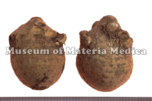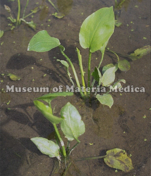Alisma Tuber

|
Market name:川澤瀉 Photo location:Museum of Materia Medica, Inst. of Nat. Med. TMPW No.:4622 |

|
Plant name:Alisma orientale Photo location:South Jeolla Prov., Korea Photo date:1998 Photographer:K. Komatsu |
| Synonym | |
| Latin name | Alismatis Tuber |
| Botanical source: Family name | Alismataceae |
| Botanical source: Plant name | Alisma orientale Juzepczuk (IPNI:58233-1) |
| Part used | Tuber |
| Empirical criteria for quality selection | Good one is enlarged, spherical and the inside is whitish. The inside of second class is light brown in color. (TN) |
| Constituents | Sugar: Sucrose Monosaccharides: D-Glucose, D-Fructose Polysaccharides: Starch Sesquiterpenoids: Sesquiterpene Triterpenoids: Alisol A, Alisol B, Alisol C Other aromatic compounds: Furfural Amino acids & Peptides: Amino acids, Protein |
| Pharmacological effects | Anti-fatty liver (Alisma Rhizome powder). Suppression of hepatopathy induced by carbon tetrachloride (benzene-acetone soluble fraction). Decrease in the cholesterol level in the liver and blood (arisol A, arisol A-24-monoacetate, arisol B-23-monoacete, arisol C-23-monoacetate). |
| Indications | As a diuretic and antidiarrheal drug, it is used in the treatment of oliguria, frequent urination, dizziness, thirst and retention of water in the stomach. |
| Diseases | Oliguria, Muddy and watery stool, Urodynia, Dysuria, Vertigo |
| Formulas | ireito , inchingoreisan , ureitsukisan , keihito , kogikujiogan , goshajinkigan , gorinsan , goreisan , saireito , shireito , jofuto , jingyobofuto , takushato , chibakujiogan , choreito , choreitogoshimotsuto , tokishakuyakusan , tokishakuyakusankaogichoto , tokishakuyakusankaninjin , tokishakuyakusankabushi , dokkatsuto , hachimijiogan , hangebyakujutsutemmato , bukuryotakushato , bunshoto , hokikenchuto , mibakujiogan , ryutanshakanto , rokumigan |
| Meridian tropism | Kidney, Gall bladder |
| Property | Cold |
| Flavor | Sweet |
| Classification in "Shen-non Ben-cao Jing" | Superior |
| TCM: Classification | Diuretics with removing dampness |
| TCM: Medicinal effects | To cause diuresis and to remove damp-heat.: For edema with oliguria, diarrhea with diminished discharge of urine, vertigo due to retention of fluid, acute urinary infection of difficult painful urination, hyperlipemia. |
| Remarks | Listed in the Japanese Pharmacopoeia 18th ed. |
| References | TN: T. Namba & Y. Tsuda ed., Outline of Pharmacognosy, a Textbook, 3rd ed., Nankodo Co., Ltd., Tokyo, 1998. |
DNA sequences of medicinal plants
| Gene Region | |||||||||||||||||||
| Nuclear | Chloroplast | Mitochondria | |||||||||||||||||
| Botanical source: Plant name | 5Ss | 18S | ITS1 | 5.8S | ITS2 | 26S | others | trnH-psbA | matK | trnK | trnK-rps16 | trnT-L | trnL | trnL-F | rbcL | rpoC1 | ndhF | others | |
|
|
|||||||||||||||||||
